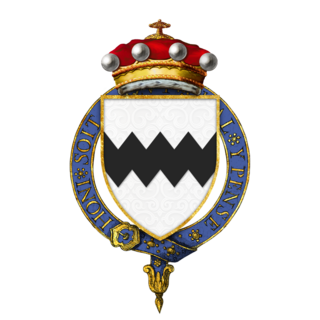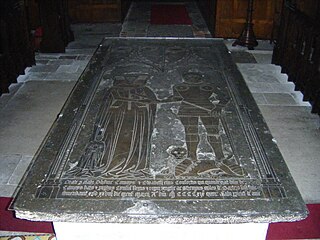Related Research Articles
Thomas Grey, 1st Marquess of Dorset, 1st Earl of Huntingdon, 7th Baron Ferrers of Groby, was an English nobleman, courtier and the eldest son of Elizabeth Woodville and her first husband Sir John Grey of Groby. Her second marriage to King Edward IV made her Queen of England, thus elevating Grey's status at court and in the realm as the stepson of the King. Through his mother's endeavours, he made two materially advantageous marriages to wealthy heiresses, the King's niece Anne Holland and the King’s cousin, Cecily Bonville, 7th Baroness Harington. By the latter, he had 14 children.

William Hastings, 1st Baron Hastings KG was an English nobleman. A loyal follower of the House of York during the Wars of the Roses, he became a close friend and one of the most important courtiers of King Edward IV, whom he served as Lord Chamberlain. At the time of Edward's death he was one of the most powerful and richest men in England. He was executed following accusations of treason by Edward's brother and ultimate successor, Richard III. The date of his death is disputed; early histories give 13 June, which is the traditional date.

The barony of Camoys was created twice. From 26 November 1313 to 1 April 1335 Ralph de Camoys (d.1336) was summoned to Parliament by writ, and is thereby held to have become Baron Camoys of the first creation. Ralph de Camoys (d.1336) married firstly, Margaret de Brewes, daughter of William de Brewes, 1st Lord Brewes (d.1291), and secondly, Elizabeth le Despenser, daughter of Hugh le Despenser, 1st Earl of Winchester.

Baron Willoughby de Eresby is a title in the Peerage of England. It was created in 1313 for Robert de Willoughby. Since 1983, the title has been held by Jane Heathcote-Drummond-Willoughby, 28th Baroness Willoughby de Eresby.

Thomas West, 8th Baron De La Warr and 5th Baron West, KB, KG was an English courtier and military commander during the reigns of Henry VII and Henry VIII.

John Neville, 3rd Baron Neville, was an English peer, naval commander, and soldier. His second wife was Elizabeth Latimer who was the 5th Baroness Latimer in her own right.

Lionel de Welles, 6th Baron Welles, KG was an English peer who served as Lord Lieutenant of Ireland and Joint Deputy of Calais. He was slain fighting on the Lancastrian side at the Battle of Towton, and was attainted on 21 December 1461. As a result of the attainder, his son, Richard Welles, 7th Baron Welles, did not succeed him in the barony of Welles until the attainder was reversed by Parliament in June 1467.

Robert Willoughby, 6th Baron Willoughby de Eresby was an English nobleman and military commander in the Hundred Years' War.
Joan Willoughby,de jure suo jure7th Baroness Willoughby de Eresby was an English baroness in her own right.
Robert Welles, 8th Baron Willoughby de Eresby and 8th Baron Welles, was the son of Richard Welles, 7th Baron Welles, and Joan Willoughby, 7th Baroness Willoughby de Eresby. He was the prime mover in an uprising against Edward IV in 1470, although his actions were possibly orchestrated by Richard Neville, 16th Earl of Warwick.
Sir Christopher Willoughby, de jure10th Baron Willoughby de Eresby, KB, was heir to his second cousin, Joan Welles, 9th Baroness Willoughby de Eresby, in her own right Lady Willoughby, as well as great-grandson and heir male to William Willoughby, 5th Baron Willoughby de Eresby. Christopher Willoughby was also heir to his elder brother, Robert Willoughby, who died unmarried and underage on 24 March 1467. He was unable to enjoy his inherited title as a result of the attainders of his cousin Joan Welles' father, Richard Welles, 7th Baron Welles, and brother, Robert Welles, 8th Baron Willoughby de Eresby.

Thomas de Camoys, 1st Baron Camoys, KG, of Trotton in Sussex, was an English peer who commanded the left wing of the English army at the Battle of Agincourt in 1415.

Alianore Holland, Countess of March was the eldest daughter of Thomas Holland, 2nd Earl of Kent, and the wife of Roger Mortimer, 4th Earl of March, heir presumptive to her uncle, King Richard II. Through her daughter, Anne Mortimer, she was the great-grandmother of the Yorkist kings Edward IV and Richard III. She was governess to Richard II's wife, Isabella of Valois.

John Montagu, 3rd Earl of Salisbury and 5th and 2nd Baron Montagu, KG was an English nobleman, one of the few who remained loyal to Richard II after Henry IV became king.

Elizabeth Mortimer, Lady Percy and Baroness Camoys, was a medieval English noblewoman, the granddaughter of Lionel of Antwerp, 1st Duke of Clarence, and great-granddaughter of King Edward III. Her first husband was Sir Henry Percy, known to history as 'Hotspur'. She married secondly Thomas Camoys, 1st Baron Camoys. She is represented as 'Kate, Lady Percy,' in Shakespeare's Henry IV, Part 1, and briefly again as 'Widow Percy' in Henry IV, Part 2.
Richard Welles, 7th Baron Welles (c.1428–1470), was an English nobleman and soldier. From a Lancastrian family, he came to be on good terms with the Yorkist King Edward IV, but was later executed after being associated with a plot against Edward known as the "Welles Uprising".
Mary Hungerford, Baroness Botreaux, Hungerford and Moleyns was the daughter of Sir Thomas Hungerford and Anne, daughter of Henry Percy, 3rd Earl of Northumberland.

William Willoughby, 5th Baron Willoughby de Eresby KG was an English baron.
Sir Richard Hastings, Baron Welles, was the son of Sir Leonard Hastings and a younger brother of William Hastings, 1st Baron Hastings. He was a favourite of Edward IV, who granted him the lands of the baronies of Willoughby and Welles after he had married the heiress, Joan Welles. He fought at Tewkesbury. He died in 1503, and was buried at the Greyfriars, London.
Sir Ralph Hastings, third son of Sir Leonard Hastings, was a supporter of the House of York during the Wars of the Roses. He fought at the Battle of Barnet, and was knighted at the Battle of Tewkesbury. He held numerous offices during the reign of Edward IV, including Keeper of the Lions and Leopards in the Tower of London, and Lieutenant of Guisnes and Captain of Calais.
References
- Archbold, William Arthur Jobson (1899). . In Lee, Sidney (ed.). Dictionary of National Biography . Vol. 60. London: Smith, Elder & Co. pp. 168–169.
- Burke, John (1831). A General and Heraldic Dictionary of the Peerages of England, Ireland and Scotland, Extinct, Dormant and in Abeyance. London: Henry Colburn. p. 562 . Retrieved 7 October 2013.
- Cokayne, George Edward (1926). The Complete Peerage, edited by Vicary Gibbs. Vol. VI. London: St. Catherine Press.
- Cokayne, George Edward (1959). The Complete Peerage, edited by Geoffrey H. White. Vol. XII, Part II. London: St. Catherine Press.
- Hicks, Michael (2004). "Welles, Leo, sixth Baron Welles (c.1406–1461)". Oxford Dictionary of National Biography (online ed.). Oxford University Press. doi:10.1093/ref:odnb/28998.(Subscription or UK public library membership required.)
- Jones, Michael K.; Underwood, Malcolm G (1992). The King's Mother: Lady Margaret Beaufort, Countess of Richmond and Derby. Cambridge: Cambridge University Press. ISBN 9780521447942 . Retrieved 7 October 2013.
- Richardson, Douglas (2011). Everingham, Kimball G. (ed.). Magna Carta Ancestry: A Study in Colonial and Medieval Families. Vol. I (2nd ed.). Salt Lake City. ISBN 978-1449966379.
{{cite book}}: CS1 maint: location missing publisher (link) - Richardson, Douglas (2011). Everingham, Kimball G. (ed.). Magna Carta Ancestry: A Study in Colonial and Medieval Families. Vol. II (2nd ed.). Salt Lake City. ISBN 978-1449966386.
{{cite book}}: CS1 maint: location missing publisher (link) - Richardson, Douglas (2011). Everingham, Kimball G. (ed.). Magna Carta Ancestry: A Study in Colonial and Medieval Families. Vol. IV (2nd ed.). Salt Lake City. ISBN 978-1460992708.
{{cite book}}: CS1 maint: location missing publisher (link)